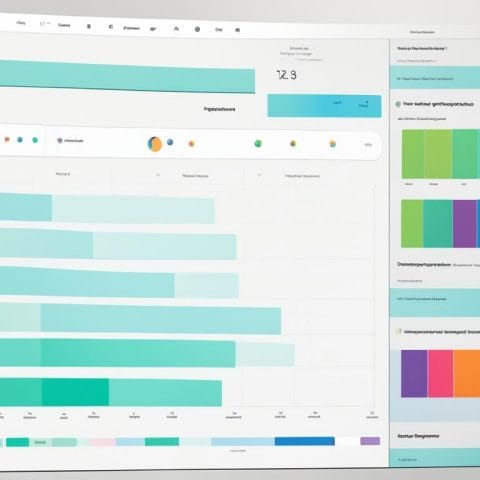Advances in technology and open communication have revolutionized the way remote teams collaborate, leading to significant creative breakthroughs for businesses worldwide. In today’s virtual work environment, fostering remote team creativity is essential for driving innovation and staying ahead of the competition.
Remote team creativity refers to the ability of teams to generate fresh ideas, think outside the box, and solve complex problems, regardless of physical distance. By tapping into the collective strength of diverse individuals and leveraging their unique perspectives, remote businesses can unlock untapped potential and unlock groundbreaking solutions.
Virtual team building activities that focus on fostering creativity play a crucial role in enhancing collaboration, increasing productivity, and nurturing a positive work culture. When team members feel inspired and empowered to think creatively, they are more likely to produce innovative solutions that drive business growth.
Key Takeaways:
- Invest in continuous learning and development to nurture the creative spirit in remote teams.
- Foster a culture of creativity through opportunities to shake up routines and recognize and reward innovative ideas.
- Support employee well-being and work-life balance to create a positive and innovative work environment.
- Leverage technology and collaboration tools to facilitate seamless communication and idea sharing.
- Create opportunities for fun and connection to foster creativity and build strong relationships.
Invest in Continuous Learning and Development
In order to keep remote teams motivated and encourage fresh ideas, continuous learning and development are crucial. By investing in learning activities, remote businesses can create a culture of curiosity and innovation among their team members. Hosting networking events, training workshops, and mentorship opportunities are effective ways to nurture the creative spirit and promote continuous growth and learning.
“Investing in continuous learning and development is like planting seeds of creativity that grow into a garden of innovation.”
Mentorship opportunities play a vital role in fostering continuous learning and development. Pairing experienced team members with less experienced ones allows for knowledge transfer and skill enhancement. This mentorship dynamic encourages the exchange of ideas, provides guidance, and helps remote team members reach their full potential.
The Benefits of Continuous Learning and Development:
- Keeps team members motivated and engaged
- Encourages fresh ideas and innovative thinking
- Enhances skills and knowledge
- Builds a culture of curiosity and growth
- Increases job satisfaction and retention
Mentorship Opportunities:
Mentorship is a powerful tool that empowers individuals to excel by learning from the experiences and wisdom of others.
Remote businesses can establish mentorship programs where team members are paired based on their skills, interests, and career goals. This allows for personalized guidance and support, creating an environment where continuous learning and development flourish.
Investing in Continuous Learning and Development:
By prioritizing continuous learning and development, remote businesses not only support individual growth but also foster a more innovative and dynamic remote team. Providing opportunities for networking, training workshops, and mentorship allows team members to expand their knowledge, collaborate with others, and stay ahead of industry trends.
| Benefits of Continuous Learning and Development | Mentorship Opportunities |
|---|---|
| Keeps team members motivated and engaged | Establish mentorship programs |
| Encourages fresh ideas and innovative thinking | Pair experienced team members with less experienced ones |
| Enhances skills and knowledge | Enable knowledge transfer and skill enhancement |
| Builds a culture of curiosity and growth | Provide personalized guidance and support |
| Increases job satisfaction and retention | Nurture continuous learning and development |
Foster a Culture of Creativity
Fostering a creative culture is critical for remote businesses to solve problems and stay innovative. When creativity is encouraged and nurtured, teams are empowered to think outside the box and come up with innovative solutions. Here are some effective strategies to foster a culture of creativity in remote teams:
- Offer opportunities to shake up routines: Encourage team members to break away from their daily routines and explore new approaches to their work. Embracing flexibility and allowing for experimentation can spark creativity and encourage problem-solving.
- Create creative spaces: Designate areas or virtual channels where team members can freely share ideas and brainstorm together. Whether it’s a dedicated Slack channel or a regular video conference for creative discussions, providing platforms for collaboration helps unlock the full potential of remote teams.
- Recognize and reward creativity: Celebrate and appreciate the creative contributions of individuals and teams. Recognizing their efforts and rewarding them not only boosts morale but also reinforces the value of creativity within the organization.
By fostering a culture of creativity, remote teams can tap into their problem-solving abilities and find innovative solutions to challenges. Encouraging creativity as it happens helps maintain a steady flow of fresh ideas and promotes an environment of continuous improvement.
Take a look at the image below to see a visual representation of how fostering a creative culture contributes to problem-solving and innovation:
| Without a Creative Culture | With a Creative Culture | |
|---|---|---|
| Problem-Solving Approach | Conventional thinking | Out-of-the-box thinking |
| Team Collaboration | Isolated work | Active collaboration and idea-sharing |
| Innovation | Stagnant progress | Continuous improvement and innovation |
As shown in the table above, fostering a creative culture leads to a more dynamic and innovative remote team. By encouraging creativity and providing the necessary support, remote businesses can unlock their teams’ creative potential and drive problem-solving and innovation.
Support Employee Well-being and Work-Life Balance
Supporting employee well-being and work-life balance is crucial for enhancing creativity in remote teams. When employees feel valued and supported, they are more likely to be engaged and motivated, resulting in higher levels of innovation and productivity. Remote businesses can take various steps to prioritize employee well-being and create a healthy work environment that fosters creativity.
Improving Health Benefits
One way to support employee well-being is by enhancing health benefits. Remote businesses can provide comprehensive healthcare coverage, including mental health services and wellness programs. This demonstrates a commitment to the overall well-being of their team members and helps prevent burnout, stress, and other related issues that can hinder creativity and productivity.
Offering Flexible Schedules
Flexibility in scheduling is another important aspect of promoting work-life balance. Remote businesses should allow employees to have control over their working hours and accommodate personal commitments. This flexibility empowers employees to manage their work and personal responsibilities effectively, leading to better work-life integration and increased job satisfaction.
Providing Long-Term Work-from-Home Options
Long-term work-from-home options are becoming increasingly popular in remote teams. By offering this flexibility, businesses enable employees to create a comfortable and conducive work environment tailored to their preferences. This arrangement promotes work-life balance, minimizes commuting stress, and allows team members to allocate more time and energy towards creative pursuits.
Addressing Burnout and Prioritizing Employee Wellness
Burnout prevention is crucial for maintaining employee well-being and creativity. Remote businesses should actively check in with their team members, provide resources for stress management, and encourage regular breaks. Prioritizing employee wellness programs and initiatives, such as virtual fitness classes or mindfulness workshops, can contribute to a positive work culture and foster a sense of well-being among remote employees.
By prioritizing employee well-being and work-life balance, remote businesses create an environment where team members feel supported and empowered. This, in turn, allows for enhanced creativity, innovation, and overall team success.
| Benefits of Supporting Employee Well-being and Work-Life Balance |
|---|
| Increased employee satisfaction and engagement |
| Higher levels of creativity and innovation |
| Reduced burnout and stress levels |
| Improved work-life integration and balance |
| Enhanced employee retention and loyalty |
Leverage Technology and Innovation

The use of technology and innovation is key to boosting creativity in remote teams. Leveraging the right tools and platforms can enhance collaboration, streamline communication, and foster a culture of innovation.
One of the most popular and widely used collaboration tools is Zoom. With its video conferencing capabilities, screen sharing, and interactive whiteboards, Zoom enables remote teams to connect and brainstorm seamlessly. This not only facilitates real-time collaboration but also encourages more effective brainstorming sessions.
Another essential tool for remote work is Asana. Asana provides a centralized platform for task management and project tracking. Remote teams can create, assign, and track tasks, ensuring everyone is on the same page and deadlines are met. This streamlined workflow allows team members to focus their energy on creative problem-solving and brainstorming sessions.
Slack is yet another powerful tool for remote collaboration. With its instant messaging, file sharing, and channel organization features, Slack enables remote teams to communicate and collaborate in real time. The ability to create dedicated channels for specific projects or topics fosters focused discussions and encourages the exchange of ideas.
By leveraging these collaboration tools and encouraging remote teams to spend more time collaboratively brainstorming, businesses can tap into the creative potential of their remote workforce.
Comparison of Collaboration Tools
| Collaboration Tool | Main Features | Benefits |
|---|---|---|
| Zoom | Video conferencing, screen sharing, interactive whiteboards | Real-time collaboration, seamless brainstorming, face-to-face interaction |
| Asana | Task management, project tracking, deadlines | Streamlined workflow, improved productivity, better task visibility |
| Slack | Instant messaging, file sharing, channel organization | Real-time communication, focused discussions, efficient collaboration |
These are just a few examples of the many collaboration tools available to remote teams. The right combination of tools will depend on the specific needs and preferences of the organization. By leveraging technology and embracing innovation, remote teams can unlock their creative potential and drive impactful results.
Provide Cross-Training and Collaboration Opportunities
Cross-training and collaboration are vital for fostering a creative and collaborative environment in remote teams. When team members have the opportunity to be cross-trained in various projects and processes, they bring a fresh perspective and develop new skills that can drive innovation. The exchange of ideas and expertise through collaboration further enhances the creative potential of the team.
To establish a comprehensive cross-training program, it is important to set clear expectations and goals. Simulations should be conducted to test the effectiveness of the training, ensuring that team members are equipped with the necessary skills to contribute their ideas and insights effectively. Open communication channels and mentorship opportunities should also be prioritized, allowing individuals to learn from one another and exchange knowledge.
By providing cross-training and collaboration opportunities, remote businesses can create an environment that encourages creativity, enhances problem-solving abilities, and fosters a sense of teamwork among team members.
| Benefits | Description |
|---|---|
| Enhanced Creativity | Cross-training and collaboration enable individuals to bring different perspectives to the table, leading to more innovative ideas and solutions. |
| Increased Productivity | Collaborative efforts allow team members to work together more efficiently, leveraging each other’s strengths and expertise. |
| Improved Problem-Solving | When team members are cross-trained, they gain a better understanding of various processes and can contribute to finding effective solutions to complex problems. |
| Enhanced Communication | Collaboration fosters open communication among team members, enabling seamless information sharing and idea exchange. |
| Continuous Learning | Engaging in cross-training and collaboration opportunities encourages ongoing learning and professional growth for team members. |
“Cross-training and collaboration provide a platform for diverse perspectives and skill sets to converge, resulting in a well-rounded and innovative team.” – Jane Smith, Creative Director
Prioritize Open Communication

Open communication plays a crucial role in keeping remote teams motivated, engaged, and free from stagnation. By prioritizing open communication, remote businesses can create an environment that fosters collaboration, boosts morale, and enhances overall team performance.
Regularly asking for feedback is an integral part of open communication. Whether it’s through face-to-face meetings or anonymous surveys, feedback provides valuable insights into the team’s dynamics, challenges, and opportunities for improvement. It empowers team members to share their thoughts and ideas, ensuring that everyone’s voice is heard and valued.
Creating a culture of open dialogue is equally important. Encouraging team members to openly express their opinions and perspectives promotes a sense of psychological safety and trust within the team. When ideas flow freely and discussions are open, it sparks creativity, drives innovation, and leads to better problem-solving.
“Open communication is the cornerstone of effective collaboration. It fosters trust, builds stronger relationships, and encourages the exchange of diverse ideas.” – Emily Johnson, Team Manager at TechSolutions
Benefits of Prioritizing Open Communication
Prioritizing open communication in remote teams brings a multitude of benefits:
- Enhanced creativity: When team members openly share their thoughts, perspectives, and experiences, it creates a rich pool of ideas that can fuel creative thinking and innovation.
- Improved problem-solving: Open communication allows for the exchange of diverse viewpoints and encourages constructive discussions, leading to more effective problem-solving and decision-making.
- Increased team engagement: When team members feel heard and valued, they become more engaged, motivated, and committed to achieving shared goals.
- Stronger collaboration: Open communication nurtures trust, builds stronger relationships, and fosters a collaborative mindset, enabling teams to work together more seamlessly and effectively.
By making open communication a priority, remote businesses can cultivate a culture that thrives on open dialogue, feedback, and active engagement. This will not only enhance team dynamics but also create an environment that nurtures creativity, productivity, and innovation.
Create Opportunities for Fun and Connection
Creating a supportive and engaging work environment is essential for remote teams to foster creativity and build strong relationships. One effective way to achieve this is by organizing team-building activities and virtual events that promote employee engagement and encourage innovative thinking.
Remote businesses can arrange various team-building activities such as virtual escape rooms, gaming sessions, or company field days. These activities provide employees with opportunities to relax, unwind, and connect with their colleagues in a fun and interactive way. Engaging in team-building activities helps foster a sense of camaraderie and teamwork, which are crucial for a creative and collaborative work environment.
Furthermore, virtual events can also serve as great occasions to bring remote teams together. Organizing virtual happy hours, online workshops, or themed celebrations can help employees feel connected, boost morale, and create memorable shared experiences. These events provide a platform for team members to socialize, express their creativity, and strengthen their professional relationships.
By creating opportunities for fun and connection, remote businesses can cultivate an enjoyable work environment that fosters creativity and promotes employee engagement. Building meaningful connections among team members not only improves collaboration but also inspires innovative thinking and sparks fresh ideas.
Investing in team-building activities and virtual events is an investment in the success and growth of remote teams. These initiatives contribute to a positive company culture, enhance employee satisfaction, and ultimately drive creativity and innovation in the virtual workplace.
Conclusion
Boosting remote team creativity is essential for driving innovation and success in virtual workplaces. By implementing effective strategies, remote businesses can create an environment that fosters fresh ideas and breakthrough solutions. Investing in continuous learning and development cultivates a culture of curiosity and innovation, keeping remote teams motivated and encouraging their creative growth.
Additionally, fostering a culture of creativity is crucial for problem-solving and generating innovative solutions. Creating opportunities to shake up routines, providing spaces for idea sharing and brainstorming, and recognizing and rewarding creativity all contribute to cultivating a creative atmosphere in remote teams.
Leveraging technology and innovation, such as collaboration tools and platforms, enables seamless communication and collaboration among remote teams. Providing cross-training and collaboration opportunities gives team members a broader perspective, enhances their skills, and diversifies their creative contributions.
Furthermore, open communication plays a pivotal role in remote teams’ creativity and engagement. Regularly seeking and incorporating feedback, embracing open dialogue, and prioritizing team engagement foster collaboration and boost creativity. Finally, creating opportunities for fun and connection strengthens relationships, promotes a positive work environment, and inspires innovative thinking in virtual workplaces.
FAQ
What strategies can remote businesses use to enhance team creativity?
Remote businesses can enhance team creativity by investing in continuous learning and development, fostering a culture of creativity, supporting employee well-being and work-life balance, leveraging technology and innovation, providing cross-training and collaboration opportunities, prioritizing open communication, and creating opportunities for fun and connection.
How can continuous learning and development enhance remote team creativity?
Continuous learning and development can enhance remote team creativity by hosting networking events, training workshops, and mentorship opportunities, which nurture the creative spirit and promote continuous growth and learning among team members.
How can remote businesses foster a culture of creativity?
Remote businesses can foster a culture of creativity by offering opportunities to shake up routines, creating creative spaces for idea sharing and brainstorming, and recognizing and rewarding creativity to maintain a steady flow of fresh ideas and innovative solutions.
Why is supporting employee well-being and work-life balance important for enhancing creativity in remote teams?
Supporting employee well-being and work-life balance is important for enhancing creativity in remote teams because it promotes a healthy work environment, strengthens team members’ creative muscles, and contributes to a positive and innovative atmosphere.
How does leveraging technology and innovation boost creativity in remote teams?
Leveraging technology and innovation, such as platforms like Zoom, Asana, and Slack, enables seamless collaboration and task management, leading to fresher and breakthrough ideas among remote teams.
Why are cross-training and collaboration important for creating a creative and collaborative environment in remote teams?
Cross-training and collaboration are important for creating a creative and collaborative environment in remote teams because team members bring a fresh perspective and develop new skills when they are cross-trained in different projects and processes.
How does open communication contribute to remote team creativity?
Open communication contributes to remote team creativity by fostering team collaboration and boosting morale. Regularly asking for feedback, whether face-to-face or through anonymous surveys, and creating a culture of open dialogue are effective ways to maintain team creativity.
What are some ways to create opportunities for fun and connection in remote teams?
Remote businesses can create opportunities for fun and connection in remote teams by organizing virtual team-building activities, escape rooms, gaming sessions, or company field days to provide employees with opportunities to relax and connect with their colleagues.
How can remote businesses achieve innovative success through team creativity?
Remote businesses can achieve innovative success through team creativity by implementing strategies like investing in continuous learning, fostering a culture of creativity, supporting employee well-being, leveraging technology and innovation, providing cross-training and collaboration opportunities, prioritizing open communication, and creating opportunities for fun and connection.





